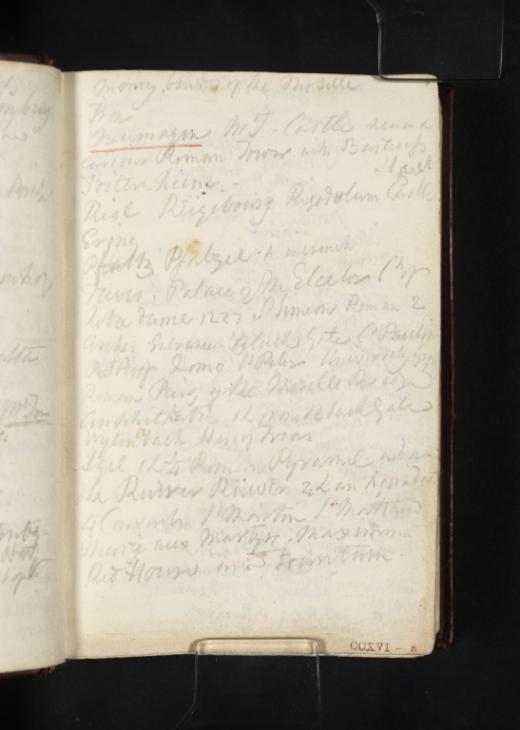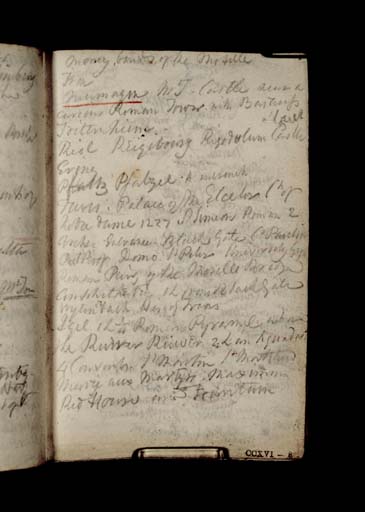Joseph Mallord William Turner Notes of Sights between Koblenz and Trier 1824
Image 1 of 2
Joseph Mallord William Turner,
Notes of Sights between Koblenz and Trier
1824
Joseph Mallord William Turner 1775–1851
Folio 8 Recto:
Notes of Sights between Koblenz and Trier 1824
D19566
Turner Bequest CCXVI 8
Turner Bequest CCXVI 8
Pencil and pen and red ink on white wove paper, 118 x 78 mm
Inscribed in pencil and pen and red ink by Turner (see main catalogue entry)
Inscribed in blue ink by Ruskin ‘8’ top right
Stamped in black ‘CCXVI–8’ bottom right
Inscribed in pencil and pen and red ink by Turner (see main catalogue entry)
Inscribed in blue ink by Ruskin ‘8’ top right
Stamped in black ‘CCXVI–8’ bottom right
Accepted by the nation as part of the Turner Bequest 1856
References
1909
A.J. Finberg, A Complete Inventory of the Drawings of the Turner Bequest, London 1909, vol.II, p.668–9.
1978
Agnes von der Borch, Studien zu Joseph Mallord William Turners Rheinreisen (1817–1844) (Ph.D thesis, Rheinischen Friedrich-Wilhelms-Universität, Bonn 1972), Bonn 1978, pp.61–2.
1980
Agnes von der Borch and Gerhard Bott, J.M. William Turner: Köln und der Rhein: Aquarelle Zeichnungen Skizzenbücher Stiche, exhibition catalogue, Wallraf-Richartz-Museum, Cologne 1980, p.86.
1991
Cecilia Powell, Turner’s Rivers of Europe: The Rhine, Meuse and Mosel, exhibition catalogue, Tate Gallery, London 1991, pp.37 note 1 [p.60], 122 no.36, 11 note 2 [p.57].
1995
Cecilia Powell, Turner in Germany, exhibition catalogue, Tate Gallery, London 1995, p.30 note 4 [p.77].
This is the last of four pages of notes Turner took from the ‘Third Excursion’ section of Alois Wilhelm Schreiber’s The Traveller’s Guide down the Rhine (see also Tate D19563–D19565; Turner Bequest CCXVI 6a–7a). The manuscript notes on these pages list the names of towns and the distances between them, sites of historical interest, antiquities, picture collections, inns and travel information for the journey between ‘Coblentz to Trêves’ when travelling ‘the course of the Moselle’.1 Turner’s use of Schreiber’s guidebook, published in English in 1818, is discussed in the general Introduction to this tour.
The artist’s notes are transcribed thus:
‘Many bends of the Moselle
Tron
Neumagen Mt T Castle near a
curious Roman Tower with Bas reliefs
Trittenheim
Riol Reigebourg Rigodulum Castle
Erzig
Pfaltz Pfalzel A intrench
Treves Palace of the Elector Ch of
Notre Dame 1227 St Simeon Roman 2
Arches Entrance Black Gate Ch Paulin
Pict Roof Domo St Peter University Gym
Roman Piers of the Moselle Bridge
Amphitheatre 1 L from Black Gate
Wyttenbach’s Hist of Treves
Igel 1 L ¼ Roman Pyramid near
The Ruwer River 2 L an Aquaduct
4 Convents St Martin St Martha and
Mary aux Martyrs Maximin
Red House and Fountain.’
Tron
Neumagen Mt T Castle near a
curious Roman Tower with Bas reliefs
Trittenheim
Riol Reigebourg Rigodulum Castle
Erzig
Pfaltz Pfalzel A intrench
Treves Palace of the Elector Ch of
Notre Dame 1227 St Simeon Roman 2
Arches Entrance Black Gate Ch Paulin
Pict Roof Domo St Peter University Gym
Roman Piers of the Moselle Bridge
Amphitheatre 1 L from Black Gate
Wyttenbach’s Hist of Treves
Igel 1 L ¼ Roman Pyramid near
The Ruwer River 2 L an Aquaduct
4 Convents St Martin St Martha and
Mary aux Martyrs Maximin
Red House and Fountain.’
Upon quitting Bernkastel and its environs, Schreiber writes that the Moselle ‘makes numerous bends, being obliged to follow the direction of the mountains’2. Indeed, the route is so full of loops and meanders that if the traveller were to follow the path along its banks ‘to his great astonishment, after several hours’ walk, he will find himself at the same point that he set out at’.3 After passing the village of Tron, the market town of Neumagen comes into view. There the ruins of an old castle can be seen, and within it ‘a curious tower, built of free-stone, which was erected by the Romans, and still bears marks of inscription and bas-reliefs’.4 The next town is Trittenheim, ‘the natal place of the celebrated John Trithemius... author of several historical works’.5 Navigating the river, the traveller enjoys a ‘range of beautiful villages’, which ‘exhibit’ themselves on both sides of its banks; he then reaches Riol, where ‘the old castle of Riegelsbourg, the Rigodulum of the Romans’ is situated.6 From the village of ‘Erang, or Ering’ (misspelt by Turner as ‘Erzig’), the traveller proceeds to Pfälzel or Pfalz, where there are the ‘remains of several ancient entrenchments... made by the Electors of Trêves’ as shelters during times of ‘dissension’.7 The Romans, too, ‘had an establishment at this place’ and ‘during the reign of the kings of the Franks, Pfälzel had a royal palace and a large farm belonging to the crown’.8
The final destination in Schreiber’s itinerary to the ‘Third Excursion’ is the ancient Roman city of Trèves. Turner’s notes show that he selected from Schreiber’s list of the city’s ‘most remarkable buildings’.9 The first of these is the ‘ancient Palace of the Elector, which has been converted into barracks’, followed by ‘the beautiful Church of Notre-Dame... built between the years 1227 and 1243’.10 Then: ‘the Church of St. Simeon, a very ancient Building’ said to have been ‘used by the Gauls for their public meetings, and by the Romans as their capitol’.11 Owing to the black colour of its ‘two grand arches, which once formed the entrance of the town’, St Simeon was renamed ‘Black Gate’ or the Porta Negra.12 Next on Turner’s list is the Church of St Paulin, which boasts a ceiling ‘ornamented with a beautiful picture’, and the Cathedral of St Peter, ‘built on a small hill, and ornamented with beautiful altars and a marble gallery’.13 Schreiber also recommends a visit to the university of Trèves, for its recently converted gymnasium.14
Among the ‘monuments of Roman architecture’ to be enjoyed in the city, Turner takes note of ‘the Piers of the Bridge of the Moselle’ and the vestiges of the Amphitheatre (Schreiber advises that ‘an engraved view’ of the latter of these monuments can be seen in ‘Wyttenbach’s History of Trêves’).15 The ‘Roman pyramid’ one league and a quarter from the city and the ‘remains of a large aqueduct’ two leagues away are also worthy of an excursion.16 Just outside of Trèves, there are ‘four Benedictine abbeys; those of St Martin, St Matthew, St Marie aux Martyrs, and St Maximin’, each of which boasts beautiful settings and rich histories.17 Turner’s page and Schreiber’s account of the city end with a note on the best inns to stay at whilst sojourning at Trèves: these are The Red House and the Fountain.18
Alice Rylance-Watson
February 2014
Alois Wilhelm Schreiber, The travellers’ guide down the Rhine: exhibiting the course of that river from Schaffhausen to Holland, and describing the Moselle from Coblentz to Treves with an account of the cities, towns, villages, prospects, etc, London 1825, p.174.
Ibid pp.187–88. See also entry for ‘Rigodulum’ William Smith LLD (ed.) Dictionary of Greek and Roman Geography, vol.II (Labadius-Zymethus), London 1857, p.717. Smith defines Rigodulum as: ‘a place on the Mosella (Mosel), “protected either by mountains or the river” (Tacitus, The History, Book IV, Chapter 71). In the war with Civilis this place was occupied by Valentinus with a large force of Treviri. Civilis, who was at Mainz, marched to Rigodulum in three days (tertiis castris) and stormed the place. On the following day he reached Colonia Trevirorum (Trier). It is supposed that Rigodulum may be Reol on the Mosel. Lipsius assumes Rigodulum to be Rigol near Confluentes (Coblenz), but that is impossible. Ammianus Marcellinus places Rigodulum near Confluentes, but his authority is small; and there may be some corruption in the text”’.
How to cite
Alice Rylance-Watson, ‘Notes of Sights between Koblenz and Trier 1824 by Joseph Mallord William Turner’, catalogue entry, February 2014, in David Blayney Brown (ed.), J.M.W. Turner: Sketchbooks, Drawings and Watercolours, Tate Research Publication, April 2015, https://www


